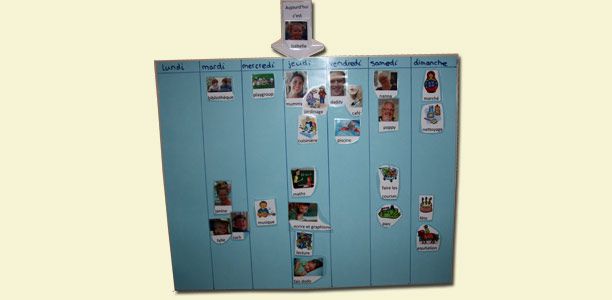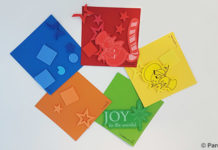Age
This activity is suitable for children 18 months upwards.
Number of participants
Sole activity, but it is good if parent guides child if they are young, or for older children until they get the hang of it.
Duration
You can play this game for just a couple of minutes, or up to half an hour.
Materials/equipment
- Timetable printable template (in language of your choice)
- Glue stick
- Blu-tac for sticking to the wall
- Card (optional)
- Photos of loved ones and friends (optional)
- Laminating materials (optional)
Cost
$2.30 Printing and laminating the timetable activities will cost about $2.00 and the card around 30c for an A4 sized timetable. If you go with a very large piece of card this activity will cost up to $15 (around $2.30 for A2 card and $11 to laminate it, plus then laminating with your own A4 laminator and the individual activities).
There is no need to laminate, and using just paper rather than card will suffice, just bear in mind they won’t last as long.
Preparation
- Print the timetable template (in preferred language) in colour. See download section below.
- Cut out the ‘today is’ wording and stick inside the arrow (with a glue stick).
- Measure the length of your card and divide by 7. Evenly space lines to divide the card into columns for each day.
- Cut out the days of the week and stick onto a large piece of card (use glue stick) or simply write the days of the week neatly.
- Optional: You may want to laminate your card at this stage so it does not become damaged with use.
- Laminate the arrow and activities with pictures.
- Optional – names of child, parent, family, friends with names under them (the same style as the activities with pictures). Laminate these.
- Cut each activity out.
- Stick the piece of card with days of the week to the wall at child’s eye level.
- Stick the arrow above week day it is that day.
- Place all activities (significant others) in an envelope or little box and blu tac to wall next to timetable.
If you don’t have a printer and laminator, make everything by hand:
- Write days of week on a piece of card.
- Cut out a card arrow.
- Draw activities and write what activity is clearly under it.
Older children can do cutting and pasting themselves. They can also help draw activities which aren’t provided on the template and create their own name/photos for family and friends they see (this may involve drawing and colouring a portrait if you don’t have a photo handy).
How to play
- Each day ask child what day it is. Get them to move the arrow above the correct day of the week.
- Your child will likely have a regular schedule of activities you may keep stuck on the timetable. For new (or seasonal activities), ask the child to find it (out the envelope or box you are storing them all in) and blu-tac it into the right place in the timetable.
- Speak to your child about the activity – ask them who will be there, what it will involve, what time you’re going to build up their language skills.
Modifications on how to play
- You can use this activity as a journal, not just a foreward planning timetable. To do this at the end of the day ask the child what they did today and get them to replay their day and discuss what they did, what they did and didn’t enjoy, how they felt etc.
- For older children, keep the picture and word describing the picture cut separately and ask the child to find the picture and the word and place them on the timetable.
Safety concerns
Beware some children may try to eat the blu-tac.
Benefits of this game/play
This timetable activity will help your child develop maths, social, language and fine motor skills. Maths skills Using this timetable activity will help your child develop numerous mathematical skills, for example they learn about time and sequence, develop memory skills and develop mathematical language (e.g. when speaking about time of the day like morning or units of time like hours). Social Understanding daily routines and talking about them plays an important role in young children’s social development. Learning about routine
- Routines are an important aspect of life and having routines provides children comfort and safety because they allow them to anticipate what will happen in the future (e.g. when mum will return). They also help children behave positively and cope with transitions (e.g. going to bed after a busy day).
Communication
- Drawing pictures and doing other art helps children communicate emotions, for example they create artworks which express their feelings and things they know.
Language development
- You and your child will be talking to each other as they play this game. It seems like a very simple thing but children learn new words and how to arrange words in sentences through the simple act of talking.
Literacy
- Using the picture cards and seeing the words for days of the week will help your child develop early literacy skills. For example they will be learning to associate meanings with pictures when they talk about their own experiences which relate to a picture, and begin to understand that printed words also carry meaning (even if they are still too young to read).
Motor skills
- When children do this timetable activity they use their fingers to manipulate the cards and stick them on the timetable. Older children who draw and cut their own cards also use their fingers in the process. This helps develop their fine motor skills and perfect actions like gripping art tools such as pencils and scissors.
Download timetable printable template
Download the timetable in:
References
- American Academy of Pediatrics. The complete and authoritative guide- Caring for you baby and young child- birth to age 5. 5th ed. Bantum Books. 2009. Book
- Zero to Three- National Institute for Infants, Toddlers and Families. Love, learning and routines. (cited 21 June 2013). Available from: URL link
- Queensland School Curriculum Council. Supporting your child’s reading development. 2007. (cited 21 June 2013). Available from: URL link
- Virginia Early Childhood Development Alignment Project. Milestones of Childhood Development- A guide to young children’s learning and development from birth to age five. 2009. (cited 21 June 2013) Available from: URL link



 (13 votes, average: 4.69 out of 5)
(13 votes, average: 4.69 out of 5) 






